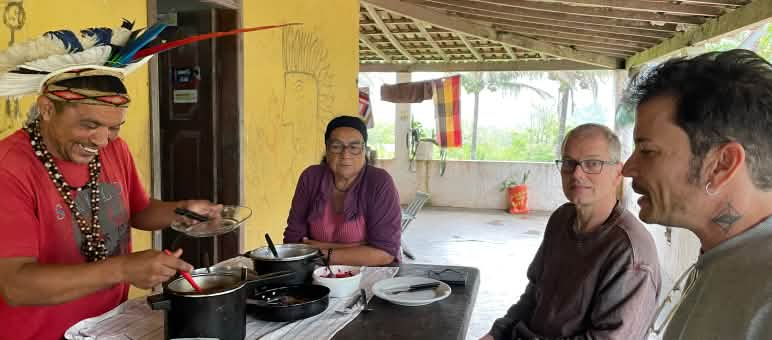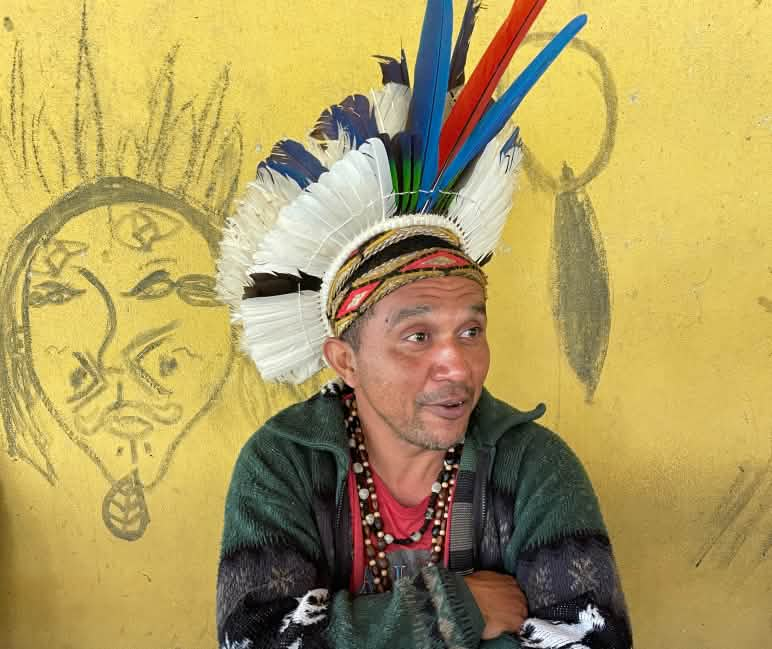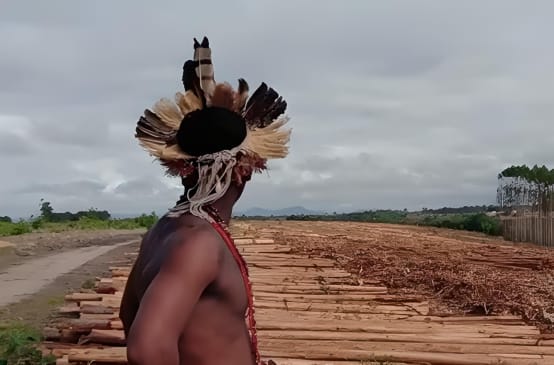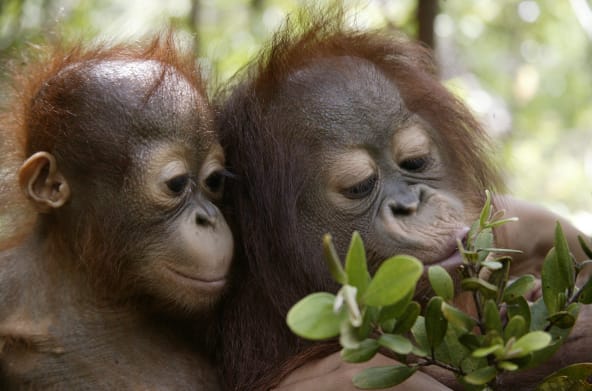
Visiting the Pataxó in Bahia
Our colleagues Guadalupe Rodríguez, Felipe Sabrina, and Klaus Schenck are traveling through the Brazilian states of Bahia, Maranhão, and Pará on behalf of Rainforest Rescue to visit our partner organizations. Their journey will conclude with participation in the People’s Summit, held alongside the COP30 World Climate Conference in mid-November in Belém, in the Amazon region.
Our first stop is in the south of Bahia state. The weather is unsettled – it’s rainy and the light is dull and gray. The journey from Porto Seguro to the Prado municipality takes four hours. In the village of Guarani, the paved road ends – from there, we travel a slippery, muddy track full of potholes. We bump, slide, and sway across hilly ground in our 4WD.
Large landowners have claimed the region, as the signs and gates at entrances make clear. The once biodiverse Atlantic rainforest along the road has been replaced by cattle pastures. The area has become degraded to varying degrees – here and there, we see Zebu cattle grazing for the beef industry. Between the pastures are plantations of coffee, cacao, papaya, and pepper.

Southern Bahia is a center for the paper and pulp industry
Time and again, we pass monotonous eucalyptus plantations. The spindly trees reach up to 30 meters into the sky in endless rows. They provide no habitat for animals or plants. These monocultures, and the pesticides used in them, destroy the delicate soils and poison water sources.
The paper and pulp companies Suzano, Veracel (a joint venture of Brazil’s Suzano Group and the Swedish-Finnish Stora-Enso Group), and Aracruz operate one of their main production regions here in southern Bahia and the neighboring state of Espírito Santo. Brazil exports 15 million tons of pulp per year, with one million tons of eucalyptus pulp shipped annually to Germany alone.

After 30 kilometers and two and a half hours on the road, we arrive at the Indigenous village of Rio do Cahy Pataxó just off the Atlantic coast. On farmland reclaimed by Indigenous people, Chief Mãdy Pataxó is waiting for us. We take our seats at a large, solid wooden table. Together with his mother, he serves us lunch. Then Mãdy begins to share his story.

Mãdy is one of the leaders of the Pataxó and active in various roles and initiatives. In 2022, he traveled through Europe, including at the invitation of the Kooperation Brasilien (KoBra) network in Germany, and visited the EU in Brussels and the United Nations in Geneva.
A history of expulsion, dispossession, and cultural destruction
The Pataxó have been under threat for more than 500 years. It was here on the coast in 1500 that a group of Portuguese “explorers” led by Pedro Álvares Cabral landed for the first time in Brazil to claim the territory for the Portuguese monarchy.
One of the most severe attacks on the Pataxó occurred in 1951. Police units raided the village of Barra Vella, set homes on fire, and beat, displaced, and killed people. The Pataxó still suffer from the attack and its aftermath today.
Beginning in the 1970s, the timber company Brasil Holanda de Industria S.A. logged valuable tropical hardwoods from the area, Mãdy tells us. As a result, there are no longer any mature commercially harvested tropical tree species here.

Today, about 20,000 Pataxó live in 50 villages. Here in Prado municipality, the Brazilian authorities began demarcating parts of the Pataxó’s traditional territory into two Indigenous lands years ago: "TI Comexatiba", with 28,000 hectares, and "TI Barra Velha do Monte Pascoal", with 53,000 hectares.
Only the final steps remain for official recognition of these two Indigenous lands, but the process has dragged on for nearly forty years. Meanwhile, large landowners and companies continue to encroach on Indigenous territory.
There are countless places where the traditional territories overlap with cattle ranches, eucalyptus plantations, tourism businesses, and government-protected areas such as Monte Pascoal National Park (223 km²).
The Pataxó respond by reclaiming land
The “National Park of Discovery” (Parque Nacional do Descobrimento, 227 km²) marking 500 years since the “discovery” of Brazil, was created by the Brazilian government in 1999 without Indigenous consultation or involvement, Mãdy reports. In 2002, the Pataxó therefore occupied the park.
Time and again, the Pataxó carry out peaceful land reoccupations, self-demarcations, and self-delineations of affected territories. There are now about 80 such areas. In 2025, the Federal Court of the 1st Region (TRF1) ruled that the Pataxó’s actions in the Indigenous land Barra Velha do Monte Pascoal were lawful.
Extreme violence against Indigenous people
Since 2022, the Pataxó have faced a new wave of raids and extreme violence, including injuries and deaths, carried out by armed groups such as “Invasão Zero”. Police officers are also involved in the attacks. Six Pataxó have been killed since then, among them the 14‑year‑old Gustavo and the Indigenous leader Nega Pataxó, both from nearby communities. At the beginning of this year, the TV station Globo Bahia broadcast a five‑part report titled “Land at War” on the situation.
Three weeks before our visit, 40 armed militiamen attacked the Pataxó just a few kilometers away and injured two Indigenous people, explains Mãdy. According to the Brazilian Indigenous Peoples’ Association APIB, the president of an agricultural association is said to have hired the men to carry out the raid and transported them by rented bus into the Indigenous territory.
Representatives of agribusiness and bloggers call the Pataxó “fake Indigenous”. They claim a handful of Indigenous people own vast tracts of land, incite hatred, and encourage violence. Meanwhile, some large landowners have seized areas even larger than those officially recognized for entire Indigenous communities.
We need the land and its resources to live, Mãdy explains. The land is our body, the water our blood, and the rainforest is our spiritual faith.
The Pataxó are planting new forests
We then set off with Mãdy to visit the nearby Ibirema Pataxó Research and Training Center. It occupies farmland reclaimed three years ago, in the middle of a 500-meter-wide corridor the Pataxó created in the eucalyptus plantations. Now, they are restoring the land with native tree species. The goal is to establish a wooded corridor between the remaining forests and protected areas, also for wildlife to use.

After talking with another Indigenous leader, Capivara Pataxó, we have to say goodbye. By 6:00 p.m., it’s already dark, the track is in bad condition and the distances in Brazil are vast.
For us, this visit marks our first direct local contact with the Pataxó. Our aim is to establish longer-term cooperation. The Pataxó need public awareness and support to advance recognition of their rights.
Tribunal Regional Federal da 1ª Região, 08/04/2025. DECISION. TRF1 recognizes the rights of the Pataxó to the Fazenda Paraíso area, in southern Bahia: https://www.trf1.jus.br/sjba/noticias/trf1-reconhece-direito-de-pataxos-a-area-da-fazenda-paraiso-no-sul-da-bahia
Articulação dos Povos Indígenas do Brasil (APIB), 7.10.2025. Associação do Agronegócio do Extremo Sul da Bahia contratou grupo que realizou o ataque contra o Povo Pataxó: https://apiboficial.org/2025/10/07/associacao-do-agronegocio-do-extremo-sul-da-bahia-contratou-grupo-que-realizou-o-ataque-contra-o-povo-pataxo/
and
Articulação dos Povos Indígenas do Brasil (APIB), 21.10.2025. Agronegócio contrata pistoleiros e tenta promover etnocídio indígena no extremo sul da Bahia: https://apiboficial.org/2025/10/21/agronegocio-contrata-pistoleiros-e-promove-etnocidio-indigena-no-extremo-sul-da-bahia/
This page is available in the following languages:

Brazil: Stop genetically modified eucalyptus trees!
A paper and pulp company wants to plant glyphosate-resistant, genetically modified eucalyptus trees in Brazil. Please speak out against this potentially disastrous plan.

The rainforest
A green sea of ferns, mosses, vines and ancient trees. Iridescent butterflies and colorful birds. Flowers in every hue of the rainbow. The “green lung” is a natural wonder of the world. Find out more about the world’s most diverse, fascinating and threatened ecosystem.